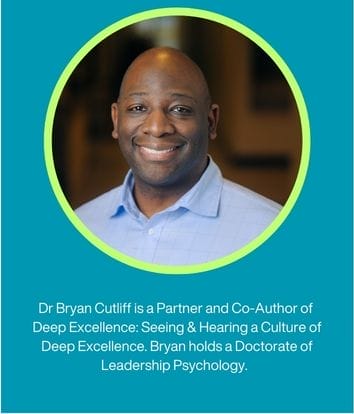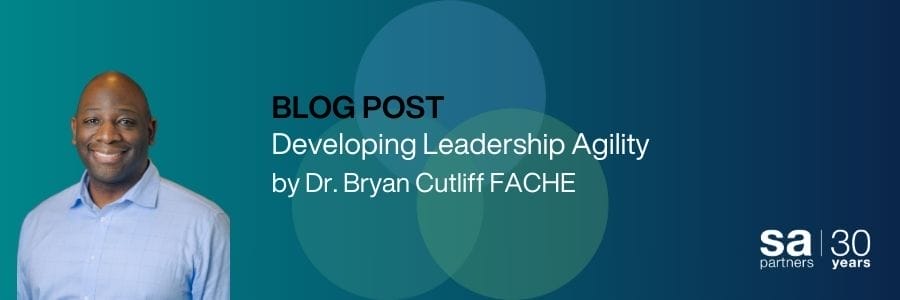 by Dr. Bryan Cutliff FACHE
by Dr. Bryan Cutliff FACHE
Leaders today engage in many diverse and complex activities and face a new set of challenges requiring agility.
These could span from accepting new roles and responsibilities to taking organizations to new heights, to navigating tremendous internal and external pressures to adopt new ways of thinking around diversity, equity, and inclusion, or directing the efforts of an organization to divest parts of itself tomake space for a new venture.
In each of these circumstances, leaders might find themselves in situations where the problem’s solution is not easily obtained and is often elusive. Solving them will require the leader’s dedication, perseverance, grit, and personal purpose to motivate themselves and others to engage in the work ahead.
In 2009, Ronald Heifetz, Alexandar Grashow, and Marty Linksy (leading authors in the space of Adaptive Leadership) suggested that the challenges the world faces today, “are not amenable to authoritative expertise, although people might hope that if the right subject matter expert could only be found, these problems would be solved. These are what we call adaptive challenges, gaps generated by bold aspirations amid challenging realities. For these, the world needs to build new ways of being, and responding, beyond the current repertories of available know-how. What is needed from a leadership perspective are new forms of improvisational expertise, a kind of process expertise that knows prudently how to experiment with never-been-tried-before relationships, means of communication, and ways of interacting that will help people develop solutions that build upon and surpass the wisdom of today’s experts.
The answers cannot come only from on high. The world needs distributed leadership because the solutions to our collective challenges must come from many places, with people developing micro-adaptations to all the different micro-environments of families, neighborhoods, and organizations around the globe.”
To develop leadership agility and truly empower those who trust us to care for the strategy of the organization, we must:
 Find your personal leadership story
Find your personal leadership story- Develop a desire to learn and adapt,
- Create personal space for reflection
- Build personal resilience; and
- Become more empathetic to the world around us.
These may seem like monumental tasks for some, but any transformation, small or large, starts with only a few critical steps.
First, carve out a time to ask yourself the following questions in the coming week:
- What patterns in my earlier life were most significant in shaping my current leadership philosophy?
- What experiences have I had that helped to develop my current passions?
- As I think about a recent failure, what were some of the learning opportunities that failure provided that could help me achieve mycurrent goals?
- What behavior could I adopt tomorrow to help me answer the above questions?
By participating in this reflective activity, you create your personal leadership story and an adaptive framework where you make it a habit tolook at past performance for clues and opportunities to improve your future performance. One key deliverable from creating personal time to reflect is that you have just started building the first four steps to creating an agile leadership presence. Some of the most inspirational leaders I have met had a strong sense of who they were and what propelled them to lead others. This story and reflection can then be used to create a realistic and personal plan to accelerate our ability to influence others for good.
The last step comes from showing empathy to yourself through this process and then subsequently to others. When we fail, we often assume that we are incapable or trusted to perform at the expected level. This mental conclusion is frequently based on an erroneous assumption, leading to poorer performance. This thinking is also often applied to others (known as the ladder of inference). In that, we assume that a person’s action today is due to some negative attribute we have labeled them with or experienced in the path. This thinking does not consider that each day brings new challenges and external forces that may cause a person to act positively or negatively in any given circumstance.
To interrupt this automatic thought process, we must 1) recognize that this happens in all of us, 2) adopt a mutual learning mindset in that we state what we are experiencing or feeling so that others know the reason for our comments, and 3) adopt an inquiring mind in which we ask the person to clarify the reason for their comments, behaviors, or results. In doing this, we become more empathetic to the situations we often put ourselves in or as we work with others on transformation efforts.
In summary, as we create personal reflection opportunities, we will learn to look at our past successes or failures as an opportunity to learn. With this learning, we will be better positioned to create an individual plan that breaks our larger goals into smaller ones, thus making it more manageable to start the change process. Lastly, we will become more empathetic with ourselves and others. As we reflect, we will start to see things that we didn’t notice now, which will help us to be less directed by negative emotions and become more hopeful about the possibilities in front of us, thus increasing our confidence, capability, and motivation to engage in the challenging work of leading others.
If your Leadership Team would benefit from coaching or mentoring please do contact me:
moc.srentrapasobfsctd-71ca68@ffiltuC.nayrB
Comment
